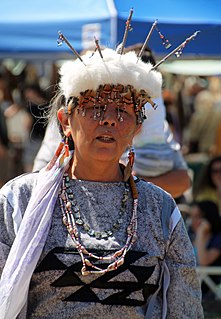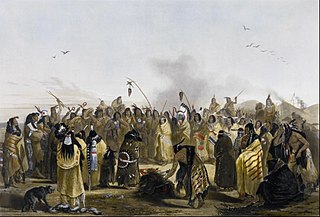
Native Americans, also known as American Indians, First Americans, Indigenous Americans and other terms, are the Indigenous peoples of the United States; sometimes including Hawaii and territories of the United States, and other times limited to the mainland. There are 574 federally recognized tribes living within the US, about half of which are associated with Indian reservations. "Native Americans" are Indigenous tribes that are originally from the contiguous United States, along with Alaska Natives.

The Taos art colony was an art colony founded in Taos, New Mexico, by artists attracted by the culture of the Taos Pueblo and northern New Mexico. The history of Hispanic craftsmanship in furniture, tin work, and other mediums also played a role in creating a multicultural tradition of art in the area.

The Pomo are an Indigenous people of California. Historical Pomo territory in Northern California was large, bordered by the Pacific Coast to the west, extending inland to Clear Lake, and mainly between Cleone and Duncans Point. One small group, the Northeastern Pomo of the Stonyford vicinity of Colusa County, was separated from the core Pomo area by lands inhabited by Yuki and Wintuan speakers.

Scalping is the act of cutting or tearing a part of the human scalp, with hair attached, from the head, and generally occurred in warfare with the scalp being a trophy. Scalp-taking is considered part of the broader cultural practice of the taking and display of human body parts as trophies, and may have developed as an alternative to the taking of human heads, for scalps were easier to take, transport, and preserve for subsequent display. Scalping independently developed in various cultures in both the Old and New Worlds.

The Colville Indian Reservation is an Indian reservation in the northwest United States, in north central Washington, inhabited and managed by the Confederated Tribes of the Colville Reservation, which is federally recognized.
The Confederated Tribes of the Colville Reservation is the federally recognized tribe that controls the Colville Indian Reservation, which is located in northeastern Washington, United States. It is the government for its people.
Black Indians are Native American people – defined as Native American due to being affiliated with Native American communities and being culturally Native American – who also have significant African American heritage.

The Piscataway or Piscatawa, are Native Americans. They spoke Algonquian Piscataway, a dialect of Nanticoke. One of their neighboring tribes, with whom they merged after a massive decline of population following two centuries of interactions with European settlers, called them the Conoy.

Charles Bird King was an American portrait artist, best known for his portrayals of significant Native American leaders and tribesmen. His style incorporated Dutch influences, which can be seen most prominently in his still-life and portrait paintings. Although King's artwork was appreciated by many, it has also been criticized for its inaccurate depictions of Native American culture.

Helmi Dagmar Juvonen (1903–1985) was an American artist active in Seattle, Washington. Although she worked in a wide variety of media, she is best known for her prints, paintings, and drawings. She is associated with the artists of the Northwest School.
Nespelem may also refer to:

The Nespelem people belong to one of twelve aboriginal Confederated Tribes of the Colville Indian Reservation in eastern Washington. They lived primarily near the banks of the Nespelem River, an Upper Columbia River tributary, in an area now known as Nespelem, Washington, located on the Colville Indian Reservation. Alternate spellings include Nespelim or Nespilim.
The Colville people, are a Native American people of the Pacific Northwest. The name Colville comes from association with Fort Colville, named after Andrew Colvile of the Hudson's Bay Company. Okanagan: sx̌ʷyʔiɬpx) Earlier, outsiders often called them Scheulpi, Chualpay, or Swhy-ayl-puh; the French traders called them Les Chaudières in reference to Kettle Falls. The neighboring Coeur d'Alene called them Sqhwiyi̱'ɫpmsh and the Spokane knew them as Sxʷyelpetkʷ.

Alaska Native cultures are rich and diverse, and their art forms are representations of their history, skills, tradition, adaptation, and nearly twenty thousand years of continuous life in some of the most remote places on earth. These art forms are largely unseen and unknown outside the state of Alaska, due to distance from the art markets of the world.

Native American civil rights are the civil rights of Native Americans in the United States. Native Americans are citizens of their respective Native nations as well as the United States, and those nations are characterized under United States law as "domestic dependent nations", a special relationship that creates a tension between rights retained via tribal sovereignty and rights that individual Natives have as U.S. citizens. This status creates tension today, but was far more extreme before Native people were uniformly granted U.S. citizenship in 1924. Assorted laws and policies of the United States government, some tracing to the pre-Revolutionary colonial period, denied basic human rights—particularly in the areas of cultural expression and travel—to indigenous people.
The Taos Society of Artists was an organization of visual arts founded in Taos, New Mexico. Established in 1915, it was disbanded in 1927. The Society was essentially a commercial cooperative, as opposed to a stylistic collective, and its foundation contributed to the development of the tiny Taos art colony into an international art center.

Earnest Spybuck was an Absentee Shawnee Native American artist, who was born on the land allotted the Shawnee Indians in Indian Territory and what was to later become Pottawatomie County, Oklahoma, near the town of Tecumseh. M. R. Harrington, an archaeologist/anthropologist, was touring the area documenting Native Americans, their history, culture and living habits. Interested in the religious ceremonies of the Shawnee which included the use of peyote, Harrington had ventured to the Shawnee Tribal lands. There he learned of Earnest Spybuck's artistic work and encouraged Spybuck in his endeavors. While Spybuck's work was obviously art, Harrington saw that he was illustrating detailed scenes of ceremonies, games, and social gatherings which could be used to illustrate many anthropological publications. Spybuck's work was received positively by both Native American and non-native artistic communities. Many of his works are now held by the Smithsonian's National Museum of the American Indian.
Women in Native American communities have been producing art intertwined with spirituality, life, and beauty for centuries. Women have worked to produce traditional art, passing these crafts down generation by generation, as well as contemporary art in the form of photography, printmaking, and performance art.

Olle Emanuel Nordmark was a Swedish painter and muralist born in Nordanholen at Mockfjärd parish. He was focused on an art career from an early age. After emigrating in 1924 to the United States to gain more work opportunities, he lived there for 40 years. Living mostly in New York City, he produced numerous murals and frescos for private commissions. In 1964, he emigrated to France, where he lived until his death.

Kate Cory was an American photographer and artist. She studied art in New York, and then worked as commercial artist. She traveled to the southwestern United States in 1905 and lived among the Hopi for several years, recording their lives in about 600 photographs.